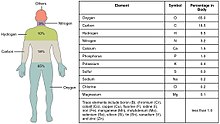Biometal (biology)

Biometals are metals normally present, in small but important and measurable amounts, in biology, biochemistry, and medicine. The metals copper, zinc, iron, and manganese are examples of metals that are essential for the normal functioning of most plants and the bodies of most animals, such as the human body. A few (calcium, potassium, sodium) are present in relatively larger amounts, whereas most others are trace metals, present in smaller but important amounts (the image shows the percentages for humans). Approximately 2/3 of the existing periodic table is composed of metals with varying properties,[1] accounting for the diverse ways in which metals (usually in ionic form) have been utilized in nature and medicine.
History
At first, the study of biometals was referred to as bioinorganic chemistry. Each branch of bioinorganic chemistry studied separate, particular sub-fields of the subject. However, this led to an isolated view of each particular aspect in a biological system. This view was revised into a holistic approach of biometals in metallomics.[2]
Metal ions in biology were studied in various specializations. In nutrition, it was to define the essentials for life; in toxicology, to define how the adverse effects of certain metal ions in biological systems and in pharmacology for their therapeutic effects.[2] In each field, at first, they were studied and separated on a basis of concentration. In low amounts, metal ions in a biological system could perform at their optimal functionality whereas in higher concentrations, metal ions can prove fatal to biological systems. However, the concentration gradients were proved to be arbitrary as low concentrations of non-essential metals (like lithium or helium) in essential metals (like sodium or potassium) can cause an adverse effect in biological systems and vice versa.[2]
Investigations into biometals and their effects date back to the 19th century and even further back to the 18th century with the identification of iron in blood.
Naturally occurring biometals
Metal ions are essential to the function of many proteins present in living organisms, such as
The uses of some of them are listed below. The list is not exhaustive, because it covers only the principal class members; others that are
Calcium
Magnesium
Manganese
Zinc
Sodium
Sodium is a metal where humans have discovered a great deal of its total roles in the body as well as being one of the only two alkali metals that play a major role in the bodily functions. It plays an important role in maintenance of the cell membrane potential and the electrochemical gradient in the body via the sodium-potassium pump and sodium-glucose transport proteins. Sodium also serves a purpose in the nervous system and cell communication as they flood into axons during an action potential to preserve the strength of the signal.[9] It has also been shown that sodium affects immune response both in efficiency and speed. Macrophages have increased proliferation rates at high-salt concentrations and the body uses high-sodium concentrations in isolated regions to generate an heightened immune response which fades after the infection has been dealt with.[10]
Potassium
In plants, potassium plays a key role in maintaining plant health. High concentrations of potassium in plants play a key role in synthesis of essential proteins in plants as well as development of plant organelles like cell walls to prevent damage from viruses and insects.[11] It also lowers the concentration of low molecular weight molecules like sugars and amino acids and increases the concentration of high weight molecular weight molecules like protein which also prevent the development and propagation of viruses.[11] Potassium absorption has a positive correlation with aquaporins and the uptake of water in plant cells via cell membrane proteins.[11] Because of this correlation, it has been noted that potassium also plays a key part in stomatal movement and regulation as high concentrations of potassium are moved into the plant stomata to keep them open and promote photosynthesis.[11] In animals, potassium also plays a key part along with sodium in maintaining resting cell membrane potential and in cell-cell communication via repolarization of axon pathways after an action potential between neurons.[9] Potassium may also play a key part in maintaining blood pressure in animals as shown in a study where increased severity of periodontal disease and hypertension were inversely correlated to urinary potassium excretion (a telltale sign of low potassium intake).[12]
Iron
Iron is also the most abundant
Lithium
Lithium is present in biological systems in trace amounts; its functions are uncertain. Lithium salts have proven to be useful as a mood stabilizer and antidepressant in the treatment of mental illness such as bipolar disorder.
Biometals in medicine
Metal ions and metallic compounds are often used in medical treatments and diagnoses.
References
- ^ Feig AL, Uhlenbeck OC (1999). "The role of metal ions in RNA biochemistry" (PDF). Cold Spring Harbor Monograph Series. 37: 287–320. Archived from the original (PDF) on 2021-03-01. Retrieved 2014-07-26.
- ^ S2CID 46997332.
- ISBN 978-94-007-5560-4.
- PMID 3905079.
- PMID 9133680.
- ^ S2CID 220268697.
- ^ S2CID 32535554.
- ^ PMID 33671781.
- ^ OCLC 1268517745.
- S2CID 195354083.
- ^ PMID 23549270.
- PMID 21826260.
- ^ PMID 34034029.
- ^ OCLC 1333920083.
- ^ PMID 8664805.
- ^ AHFS Consumer Medication Information (2014). "Lithium". Medline. U.S. National Library of Medicine.
- PMID 9189058.
- PMID 21976811.
